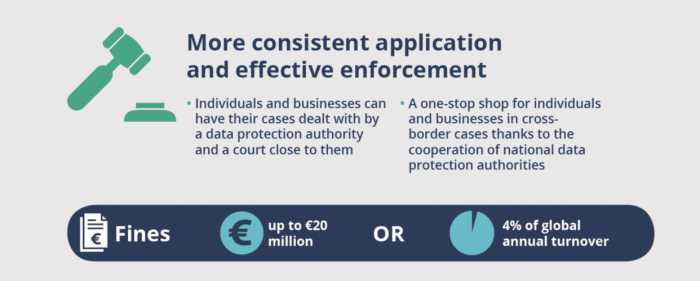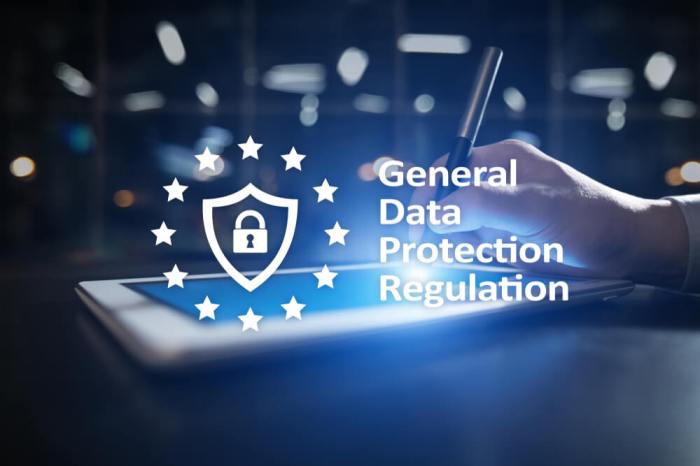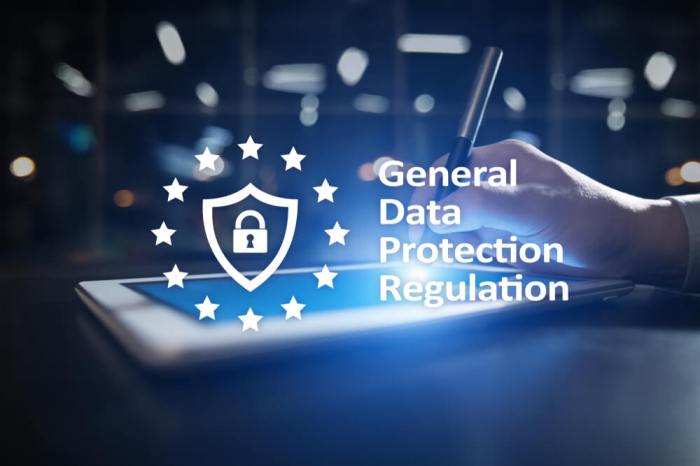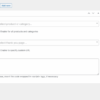Is your business GDPR ready? Navigating the complexities of the General Data Protection Regulation (GDPR) can feel overwhelming. This guide provides a comprehensive overview, from understanding the core principles to implementing practical steps for compliance. We’ll explore potential risks, best practices, and the importance of ongoing compliance in today’s data-driven world.
We’ll cover everything from understanding the fundamental principles of data protection to practical steps for assessing your current posture. You’ll discover actionable strategies to ensure your business is not only compliant but also prepared to thrive in a data-centric environment. We’ll also highlight the significance of continuous monitoring and adaptation to evolving GDPR requirements.
Understanding GDPR Compliance
The General Data Protection Regulation (GDPR) is a landmark European Union law that significantly impacts how businesses handle personal data. It’s designed to protect the fundamental rights and freedoms of individuals regarding their personal information. This comprehensive framework sets clear rules and responsibilities for organizations collecting, storing, and using personal data within the EU and those operating globally with EU citizens’ data.GDPR aims to enhance transparency, empower individuals with greater control over their data, and establish a robust legal framework for data protection.
It sets out specific principles and obligations to ensure responsible data handling.
Key Principles of GDPR
The GDPR is built on several key principles that organizations must adhere to. These include data minimization, purpose limitation, and data integrity and confidentiality. These principles guide the lawful processing of personal data. Data minimization, for instance, means collecting only the data necessary for the specific purpose.
Data Minimization and Purpose Limitation
These principles are crucial for GDPR compliance. Data minimization means collecting only the personal data strictly necessary for the specified purpose. Purpose limitation requires that data be used only for the stated, legitimate purpose for which it was collected. This ensures that individuals’ data isn’t used for purposes beyond what they agreed to. For example, if a company collects an email address for newsletter sign-ups, it shouldn’t use that same email address for targeted advertising without explicit consent.
Importance of GDPR Compliance for Businesses
Compliance with GDPR is essential for businesses operating in the EU or handling the data of EU citizens. Non-compliance can result in significant penalties and reputational damage. Proactive compliance demonstrates a commitment to data protection, builds trust with customers, and potentially avoids legal battles.
Consequences of Non-Compliance with GDPR
Failure to comply with GDPR can lead to substantial penalties. These penalties can vary depending on the severity of the violation and the level of harm caused to individuals. Moreover, non-compliance can damage a company’s reputation and erode customer trust. This can impact sales and market share in the long run.
Thinking about whether your business is GDPR compliant? It’s a crucial question, and you can actually learn a lot from exploring other creative endeavors. For example, check out this inspiring project about empowerment and self-expression: you too can create. Ultimately, a strong understanding of your data handling practices is key to ensuring your business is GDPR ready.
Types of Data Businesses Might Collect and Process
Businesses collect and process a wide array of data, including customer information, financial details, health information (in specific contexts), and browsing history. The type of data collected depends on the industry and the services offered. It is important to understand the different types of data, as they have varying implications under GDPR.
How GDPR Impacts Various Business Sectors
The GDPR’s impact spans various sectors, from e-commerce and finance to healthcare and education. Each sector must adapt its data processing practices to comply with GDPR requirements. For instance, healthcare providers must ensure patient data is protected, while e-commerce businesses need to obtain explicit consent for data collection.
Table: Common Data Types and GDPR Implications
| Data Type | GDPR Implications |
|---|---|
| Customer Name and Contact Information | Requires explicit consent for collection and processing. Transparency about how data is used must be provided. |
| Financial Data | Highly sensitive data requiring stringent security measures and explicit consent. Data encryption and secure storage are crucial. |
| Health Information | Processing is subject to strict regulations. Explicit consent and specific purposes for processing are essential. Data security measures must be implemented. |
| Browsing History | Requires explicit consent or legitimate basis for processing. Purpose limitation is critical. Transparency regarding data usage is needed. |
Assessing Business GDPR Readiness
Navigating the complexities of the GDPR can feel daunting, especially when trying to understand where your business stands. This section delves into the crucial process of assessing your GDPR readiness, equipping you with the knowledge and tools to identify potential risks and bolster your compliance posture. A proactive approach to GDPR readiness is key to minimizing potential fines and maintaining customer trust.Understanding your current level of GDPR compliance is not just about ticking boxes; it’s about actively managing the potential risks associated with personal data handling.
A thorough assessment will highlight areas needing improvement, empowering you to implement necessary changes and demonstrate a commitment to data protection.
Potential GDPR Risks in a Hypothetical Business Scenario
Businesses handling customer data face various potential GDPR risks. A hypothetical online retailer, “E-Shop,” collecting customer data for order processing and marketing purposes is susceptible to breaches. Examples include inadequate data security measures, insufficient data protection policies, and a lack of transparency regarding data usage. These vulnerabilities can lead to hefty fines, reputational damage, and legal action. A poor response to a data breach can compound the issues.
Data breaches can expose customer personal data to unauthorized access, misuse, or disclosure, leading to significant repercussions for both the business and its customers.
Different Levels of GDPR Readiness
Different levels of GDPR readiness reflect varying degrees of preparedness. A “basic” level of readiness may involve adhering to the fundamental GDPR principles but lacking a comprehensive data protection strategy. An “advanced” level encompasses a robust data protection framework, including detailed data mapping, comprehensive data protection policies, and dedicated resources for GDPR compliance. This distinction highlights the importance of tailoring your approach to your specific business context and the scale of your data handling.
Steps to Assess Your Current GDPR Posture
A systematic approach to assessing your GDPR posture is crucial. These steps involve inventorying personal data handled, reviewing policies and procedures, identifying potential risks, and evaluating existing security measures. A thorough audit of current data protection measures is necessary to pinpoint areas of weakness.
GDPR Compliance Checklist
This checklist provides a structured approach to evaluating compliance with GDPR principles:
- Data Subject Rights: Does your business have procedures in place to handle data subject requests (access, rectification, erasure, restriction, etc.)? Are you able to respond within the legal timeframe?
- Data Minimization: Are you collecting only the necessary personal data for the specified purpose? Is data retention aligned with legal requirements?
- Data Security: Have you implemented appropriate security measures to protect personal data from unauthorized access, use, or disclosure? Are you prepared for a data breach?
- Data Subject Consent: Is consent for data processing obtained legally and transparently? Is consent documented properly and easily accessible?
- Transparency and Information: Are data policies clear, concise, and easily accessible to data subjects? Is your business transparent about its data handling practices?
Categorizing Common GDPR Requirements and Business Actions
This table Artikels common GDPR requirements and the corresponding actions a business should take:
| GDPR Requirement | Business Action |
|---|---|
| Data Subject Rights | Establish a process for handling data subject requests, including access, rectification, erasure, and objection. |
| Data Minimization | Define clear data collection policies to ensure only necessary data is collected and processed. |
| Data Security | Implement technical and organizational measures to protect personal data from unauthorized access, use, or disclosure. |
| Data Subject Consent | Obtain valid and explicit consent for data processing, documenting the consent process. |
| Transparency and Information | Develop clear and concise data policies and make them readily available to data subjects. |
GDPR Readiness Assessment Workflow
This workflow diagram Artikels the process for assessing GDPR readiness:
Start with data inventory, move to policy review, followed by risk assessment. Then, evaluate security measures and data subject rights. Document the assessment findings, and identify necessary improvements. Finally, implement the improvements and regularly review the process.
Implementing GDPR-Compliant Practices: Is Your Business Gdpr Ready
Successfully navigating GDPR compliance isn’t just about understanding the regulations; it’s about actively implementing the principles within your business processes. This involves obtaining informed consent, managing data subject requests, safeguarding data, and having a robust data breach response plan. This stage necessitates a proactive and adaptable approach, ensuring your business is not only compliant but also fosters trust and transparency with data subjects.Implementing GDPR compliance requires a multifaceted approach, encompassing policies, procedures, and technological solutions.
Careful planning and consistent monitoring are crucial for maintaining compliance. This ensures that data processing activities align with GDPR principles, reducing potential risks and safeguarding your organization’s reputation.
Obtaining Informed Consent
Informed consent is a cornerstone of GDPR. It means providing clear, concise, and easily understandable information to data subjects about how their data will be used. This includes the purpose of collection, the intended use, and the potential recipients of the data. Crucially, the consent must be freely given, specific, informed, and unambiguous. Users should have the option to withdraw consent at any time.
Using pre-ticked boxes for consent is generally discouraged as it does not meet the criteria for genuine consent.
Managing Data Subject Requests
Data subjects have rights under GDPR, including the right to access, rectify, and erase their personal data. Businesses must establish clear procedures for handling these requests. This involves creating a dedicated process for receiving, reviewing, and responding to requests. The process should ensure timely responses and accurate data updates.
Implementing Data Security Measures
Data security is paramount. Implementing robust security measures to protect data from unauthorized access, use, disclosure, alteration, or destruction is essential. This includes using encryption, access controls, and regular security assessments. A comprehensive security strategy is critical to protecting sensitive data from both internal and external threats.
Data Breach Response
A comprehensive data breach response plan is vital. This plan should Artikel procedures for detecting, reporting, and mitigating the impact of a data breach. It should also involve notification procedures, especially for individuals affected by the breach. Timely response and effective communication with regulatory bodies are critical in a data breach.
Data Processing Agreements
Data processing agreements (DPAs) are contracts between a controller and a processor, outlining the responsibilities and obligations of each party. These agreements clearly define the scope of data processing activities and establish the safeguards for data protection. DPAs should be tailored to the specific processing activities involved.
Quick question: is your business GDPR ready? Understanding your target audience is crucial for ensuring compliance, and that’s where market research comes in. Conducting thorough research into client needs and preferences, like the importance of market research for professional services , will help you anticipate potential GDPR concerns and proactively put safeguards in place. This, in turn, strengthens your business’s overall GDPR preparedness.
Example: A DPA between a marketing agency (processor) and a company (controller) would detail how the agency handles customer data for marketing campaigns.
Before diving into lead generation strategies, have you considered if your business is GDPR compliant? Understanding the costs associated with lead generation services is crucial, especially when you need to ensure your processes align with data privacy regulations. Checking out a comprehensive lead generation services pricing guide how much does it cost can help you make informed decisions about budget allocation.
Ultimately, ensuring your business is GDPR ready is paramount before any lead generation campaign.
Flowchart for Handling Data Subject Requests
[A visual flowchart, not included here, would detail steps for receiving, verifying, and responding to data subject requests. It would include checks for completeness and accuracy, and potential escalation paths.]
Summary of GDPR-Related Procedures
| Procedure | Description | Key Considerations |
|---|---|---|
| Informed Consent | Obtaining explicit consent for data processing | Clarity, transparency, and user choice |
| Data Subject Requests | Responding to access, rectification, erasure, and other requests | Timely and accurate handling of requests |
| Data Security | Implementing measures to protect data | Encryption, access controls, and regular assessments |
| Data Breach Response | Planning for and responding to data breaches | Notification procedures and mitigation strategies |
| Data Processing Agreements | Contracts for data processing | Clear responsibilities and obligations for each party |
Data Protection Policies and Procedures

Data protection policies and procedures are crucial for any organization handling personal data. They provide a framework for complying with GDPR regulations, outlining how data is collected, used, stored, and protected. This section dives into the specifics of these policies, emphasizing practical application and real-world examples.Data protection isn’t just about ticking boxes; it’s about establishing a culture of data privacy within your organization.
A well-defined policy demonstrates your commitment to protecting user data, fostering trust, and mitigating potential risks. Effective policies are not static documents but living, evolving resources that adapt to changes in the regulatory landscape and your business needs.
Sample Data Protection Policy Document
This document Artikels the core principles of data protection within our organization. It details how we collect, use, and safeguard personal data, ensuring compliance with GDPR regulations. It also specifies the roles and responsibilities of all personnel involved in handling personal data.
Data Subject Access Requests (DSAR) Template
This template provides a standardized process for handling data subject access requests. It ensures a consistent approach, streamlining the request handling process and minimizing potential errors. The template includes clear instructions for responding to various types of DSARs, emphasizing the importance of timely and accurate responses.
Legal Basis for Data Processing
The legal basis for data processing is a crucial element of GDPR compliance. It justifies the organization’s use of personal data, aligning with the principles of lawfulness, fairness, and transparency. This section clarifies the various legal grounds for processing data, such as consent, contract, and legitimate interests. For example, if a company collects customer data for marketing purposes, the legitimate interest is to improve the customer experience and personalize offers.
However, a clear and detailed description of how these interests are balanced against individuals’ rights is essential.
Data Retention and Deletion Procedures, Is your business gdpr ready
Data retention and deletion policies are critical to ensure compliance with GDPR’s requirements for data minimization and storage limitations. This section details the procedures for determining data retention periods, outlining clear criteria for deleting data when no longer necessary. The procedures must also cover situations involving legal obligations or business continuity. A well-defined retention schedule prevents the accumulation of unnecessary data and safeguards against potential breaches.
Role of Data Protection Officers (DPOs)
A Data Protection Officer (DPO) plays a pivotal role in ensuring GDPR compliance. They provide guidance and oversight regarding data protection practices within an organization. This includes reviewing policies, advising on compliance issues, and assisting with investigations. A DPO ensures that data protection principles are integrated into all aspects of the organization’s operations. They serve as a key point of contact for inquiries and concerns.
Data Protection Tools and Resources
Numerous tools and resources can aid in implementing GDPR compliance. These resources include data mapping tools, data breach notification templates, and training materials. This section provides a comprehensive list of these tools, aiding organizations in identifying appropriate solutions.
Data Retention Policy Table
| Data Type | Retention Period | Legal Basis | Deletion Procedure ||—|—|—|—|| Customer Data | 5 years | Contract, Legitimate Interest | Automated deletion process after 5 years, unless consent is renewed or legal obligations exist. || Financial Transactions | 7 years | Contract | Archival and secure deletion upon expiry of the legal requirement. || Employee Records | As per legal requirements | Contract, Legitimate Interest | Deletion following termination, unless required for legal or operational purposes.
|| Marketing Data | 3 years | Consent, Legitimate Interest | Opt-out options, secure deletion upon consent withdrawal or expiry. |
Case Studies and Examples
Navigating the complexities of GDPR compliance can feel overwhelming. Real-world examples of successful implementations and, equally importantly, violations, offer invaluable insights. These case studies illuminate the practical application of the regulations and the potential repercussions of non-compliance. By studying both successes and failures, businesses can better understand the nuances of GDPR and craft strategies for effective implementation.
Successful GDPR Implementations
Companies across diverse sectors have successfully integrated GDPR principles into their operations. These implementations often involve a combination of proactive measures, comprehensive training, and a robust data governance framework.
- Netflix, known for its meticulous data handling, has consistently prioritized user privacy. Their commitment to transparent data practices, coupled with readily accessible privacy settings, demonstrates a proactive approach to GDPR compliance. They proactively informed users about their data collection practices, offering clear choices regarding data usage.
- Spotify has implemented a sophisticated system for managing user data. Their emphasis on granular control over data access, combined with a dedicated team for data protection, demonstrates a commitment to GDPR compliance. They offer users control over their listening data and actively participate in industry best practices.
- Google, a tech giant with extensive data handling, has undertaken significant steps to comply with GDPR. They have created extensive data protection policies, developed user-friendly privacy settings, and provided training to employees regarding GDPR principles. This commitment demonstrates a large-scale approach to data privacy, involving all levels of the organization.
GDPR Violations and Consequences
Understanding the consequences of GDPR violations is crucial for proactive compliance. Penalties for non-compliance can be substantial, affecting both reputation and financial stability.
- Cambridge Analytica scandal, involving the unauthorized collection and use of personal data, exemplifies the severe repercussions of GDPR violations. The scandal led to significant fines and damage to the company’s reputation. This serves as a stark reminder of the importance of safeguarding user data and adhering to privacy regulations.
- Facebook faced criticism for its data collection practices. While not a direct GDPR violation in all instances, concerns regarding data transparency and user control sparked public scrutiny and legislative attention. This demonstrates how non-compliance, even in areas where the line is blurred, can lead to significant reputational damage.
- Companies found to be in violation of GDPR’s provisions, regardless of their size, face potential legal challenges, financial penalties, and reputational damage. This highlights the importance of proactive compliance and the potential severity of non-compliance.
GDPR Compliance Approaches
Diverse approaches to GDPR compliance exist, depending on the specific needs and resources of a business. Businesses can choose strategies aligned with their organizational structure and the nature of their data processing activities.
- Proactive Compliance: A proactive approach focuses on embedding GDPR principles into every aspect of the business. It involves a systematic review of data processing activities, training of employees, and the development of clear policies and procedures.
- Reactive Compliance: A reactive approach addresses GDPR compliance after a violation has occurred or been identified. This often involves rectifying the issue and implementing measures to prevent future violations. It is less effective than a proactive approach and potentially more costly.
- Hybrid Compliance: A hybrid approach blends proactive and reactive measures. This method combines preventative strategies with the capacity to respond to emerging issues and adapt to changing circumstances.
GDPR-Compliant Privacy Policies
A robust privacy policy is crucial for demonstrating a commitment to GDPR compliance. The policy should clearly Artikel how a business collects, uses, and protects personal data.
- A well-structured privacy policy includes explicit details about data collection methods, the purposes for data use, data retention policies, and data subject rights.
- Clear and concise language is essential for ensuring transparency and comprehension by users.
- A GDPR-compliant privacy policy should be easily accessible to users and explicitly state the legal basis for data processing.
Data Subject Request Handling
Effective handling of data subject requests is a vital component of GDPR compliance. Businesses must be prepared to respond to requests efficiently and effectively.
- Businesses should have a designated process for handling data subject requests, ensuring that they are processed promptly and accurately.
- This process should Artikel timelines for responses, procedures for verifying data subject identity, and methods for fulfilling data subject rights.
- Prompt and accurate responses to requests demonstrate a commitment to data protection and user rights.
Impact on Business Operations
GDPR impacts various aspects of business operations. It necessitates adjustments to existing data management systems and procedures.
- Businesses must adapt their data storage and processing methods to align with GDPR requirements. This includes the implementation of data minimization strategies, secure storage protocols, and data deletion policies.
- Compliance necessitates staff training to ensure employees are aware of and adhere to GDPR regulations. This includes educating staff on data protection policies and procedures.
- Compliance with GDPR mandates careful consideration of data security measures and incident response plans.
GDPR Compliance Across Industries
A comparison of GDPR compliance practices across different industries reveals varying levels of complexity and requirements.
| Industry | Key Compliance Considerations |
|---|---|
| Healthcare | Stricter data protection regulations due to sensitive patient information. |
| Finance | High security requirements for financial data and adherence to financial regulations. |
| Retail | Managing customer data and ensuring transparency in data usage. |
| Technology | Complex data processing and storage requirements; focus on data minimization and user control. |
Final Summary

In conclusion, ensuring your business is GDPR-ready is not just a legal obligation, but a strategic necessity. By proactively addressing the key aspects of data protection, you can build trust with customers, minimize risks, and position your organization for long-term success. This guide offers a roadmap to help you understand and implement GDPR compliance effectively.






